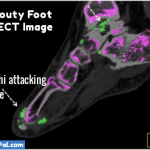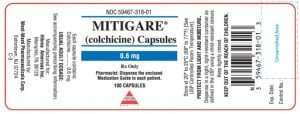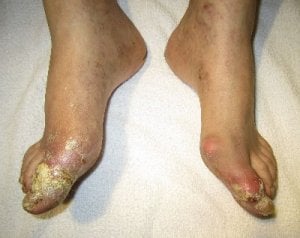Gout tests are a vital part of diagnosis and treatment. So all gout sufferers should be aware of which tests are available. More importantly, they need to understand the tests that apply at different times. Then they can arrange the right tests with health professionals.
Gout Tests Purpose
This is an overview of all the tests relevant to gout sufferers. So it introduces you to the tests your doctor might arrange. Then it links you to details of each test. Because that helps you prepare, where necessary. Importantly, it helps you discuss your test results with your doctor.
Essential Gout Tests
The most essential gout test is the uric acid blood test. Now that test must always be accompanied by blood tests for kidney function and liver function. However, the results of those function tests are beyond the scope of GoutPal. I will keep emphasizing their importance. But I will never discuss the details of kidney and liver tests. Because that is your doctor’s job.
On the other hand, I will never stop talking about uric acid blood tests for gout management. Because you cannot manage treatment without knowing your uric acid level. It’s also usually important for diagnosis, when done properly. For more see Uric Acid Test.
Most other gout tests are to help diagnose the type and extent of your gout. But they might also be used during recovery. To assess how your treatment is progressing.
Diagnostic Gout Tests
I’m currently reorganizing this section. So please use the search box near the top of the screen to find details of the following tests:
- Uric Acid 24-hour Excretion Test
- Joint Fluid Crystal Test
- Allpurinol Genetic Sensitivity Test
Recently, there have been many developments in non-invasive gout tests. It’s therefore interesting to see a comprehensive review of the current state of various imaging techniques. A new report, New insights into an old disease: advanced imaging in the diagnosis and management of gout contains a great deal of interesting information. However, the content is mainly of interest to practicing rheumatologists. There are some facts that are important for gout patients. Instead of a full review of this report, I will omit most of the technicalities. Instead, I will focus on the parts of the report that are most likely to affect gout patients now, or in the near future.
The report looks at various imaging techniques that can measure uric acid crystals and their effects. It makes the point that these techniques, though very important for initial gout diagnosis, will also play a part in measuring the effectiveness of uric acid treatment.
Gout Test Technologies
The report considers 5 imaging technologies for different gout tests:
- X-ray
- MRI
- Ultrasound
- CT
- Dual Energy Computed Tomography DECT
X-ray Gout Tests
Plain radiography, or X-rays, is the most widely available technology to help manage gout. Unfortunately, it takes 10 or more years for the effects of gout to show. In the early stages, X-rays fail to show gout, except for occasional non-specific swelling, which is obvious to the naked eye anyway. Some tophi are large enough and dense enough to show on X-rays. The most useful results of x-ray gout tests are to show damage to joints. This has led to the recent development of a joint damage scoring system.
MRI Gout Tests
MRI technology is the least used for gout due to the high cost. MRIs can detect tophi, but measurements are frequently confounded as the surrounding inflammation can be confused with the actual tophi.
Ultrasound Gout Tests
Ultrasound is being used more for gout diagnosis and management. As well as being a diagnostic tool in its own right, it can also be used to guide the needle to collect joint fluid. Progress has been made, and the ultrasound view of gout is more recognizable. Tophi can be measured, so ultrasound is an accessible way to measure how tophi shrink when uric acid is below 6mg/dL. Finally, ultrasound can detect inflammation, and so be used to measure the effectiveness of anti-inflammatory treatments.
High Resolution Ultrasound (HRUS) is another development in imaging. This technology has proved to be superior to x-rays in measuring damage.
CT Gout Tests
CT scanning is seen as the best test for tophi and bone damage. Several studies have shown reliable results, and the authors make the point that CT scans will be very helpful in measuring effects of treatment during clinical trials and other investigations.
DECT Gout Tests
DECT is the latest type of gout test and is particularly effective. It produces very clear images of the size and location of uric acid crystals. Unfortunately, it is too expensive, and still quite rare, so not available to most gout patients. However, we can all benefit from DECT as it reveals new insights into the nature of gout. We can see how joints begin to show signs of damage long before gout makes its painful presence felt. This changes the nature of gout treatment, and professional rheumatologists now recommend early uric acid lowering treatment. There is now doubt if so-called asymptomatic hyperuricemia actually exists. Rheumatologists now have the tools to study patients with long term high uric acid, even when they show no signs of gout. DECT scans can reveal if bones and other tissues are being damaged.
- New imaging modalities including CT, dual energy CT, MRI and ultrasound are all more sensitive than plain radiography in detecting early joint erosions in gout
- All these imaging modalities can be used to detect tophi, and measure tophus size
- Dual energy CT shows promise as a useful modality to help diagnose gout but cannot [currently] replace joint aspiration to detect urate crystals
- The ultrasound double contour sign may be specific for gout but multimodality studies in patients with acute and chronic gout are required to confirm this
I’ve added the qualifying currently to DECT not replacing joint fluid tests. At the moment, it is too expensive, and facilities are not widely available. This could change in the future.

Gout Tests: Next Steps
As you can see, gout tests are improving. Interesting as this is, current tests are adequate to allow gout diagnosis in all but the most complicated cases. The most important thing you can do is to arrange your personal test for gout today. If you are worried you might have gout, book to see your doctor now. Delays only mean more pain, and untreated gout causes joint damage. Prolonged untreated gout leads to organ failure, so if you value your kidneys, heart, and other organs, arrange your gout tests today.
If you need help knowing what to ask your doctor about your test for gout, or help understanding your gout test results, please ask in the gout forum.
To get an email notification as I (re)publish more gout diagnosis pages please subscribe:
Leave Gout Tests to read more Gout Symptoms, Causes, & Diagnosis facts.
Gout Tests Related Topics
Please remember: to find more related pages that are relevant to you, use the search box near the top of every page.
Common Terms: asymptomatic, test
Other posts that include these terms:
- Starting Allopurinol – Dosing Guidelines
- What is the purpose of Uric Acid Test?
- Uric Acid Test Kit
- Vitamin C & Uric Acid
- Uric Acid Tests
- Test For Uric Acid Crystals
- Best Time To Check Uric Acid Levels
Gout Tests Document Change History
 To read the document change history, click the History image on the right.
To read the document change history, click the History image on the right.
Do you have suggestions for improving Gout Tests? Then, please send your idea using the Feedback Form below.
Please give your feedback
Did this page help you? If yes, please consider a small donation. Your donations help keep GoutPal's gout support services free for everyone.
If not, please tell me how I can improve it to help you more.
- YouTube
- The gout forums.










